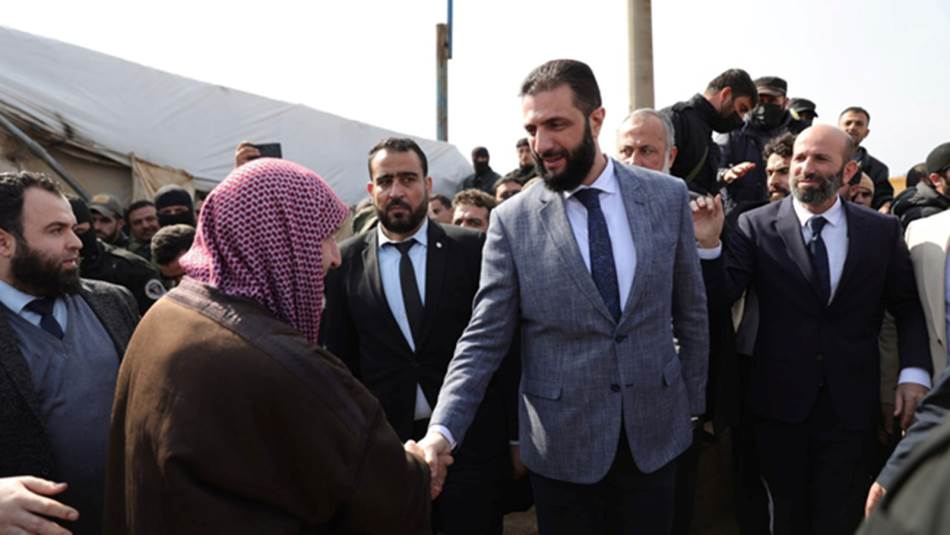In a highly symbolic visit, Syrian President Ahmad al-Sharaa arrived in Lattakia, a city long considered a stronghold of the Assad family, as part of his national tour. Marking his first official visit since taking office, Al-Sharaa met with local dignitaries from various sects to discuss pressing issues and the future of governance in the post-Assad era, according to the official Syrian News Agency (SANA).
A Carefully Orchestrated Visit Amid Tight Security
The visit unfolded under heavy security measures, with widespread deployments of security forces and the closure of key roads leading to Sheikh Daher Square, where thousands had gathered to welcome the new president. The sheer number of citizens slowed his motorcade to a crawl, turning what should have been a brief journey into a prolonged procession.
Videos circulated on social media captured a striking moment—Al-Sharaa stepping out of his personal vehicle, holding the Syrian flag, and greeting the crowd face-to-face. This direct interaction appeared to be a deliberate move to present himself as a leader of the people, a stark contrast to the detached, authoritarian image of the previous regime.
Lattakia: From Assad’s Bastion to a Political Litmus Test
Lattakia is not just another city on Al-Sharaa’s itinerary—it is the hometown of deposed President Bashar al-Assad, making it a crucial battleground for any leader aiming to cement legitimacy in the new political landscape.
The city has witnessed rising tensions in recent weeks, including mysterious kidnappings, fueling uncertainty about the future. Many observers view Al-Sharaa’s visit as a strategic move to redefine relations between the new government and Lattakia’s diverse and divided population, particularly Alawites, who found themselves at the heart of the Assad regime but now face an uncertain political future.
The location of Al-Sharaa’s reception also carried historical significance—Sheikh Daher Square, home to the Gul Jamal School, where Hafez al-Assad once studied. This square also played a key role in the celebrations following Assad’s downfall, when demonstrators toppled the statue of Hafez al-Assad in a defining moment of Syria’s recent history.
Calls for a Historic Visit to Qardaha
Al-Sharaa’s visit to Lattakia has sparked discussions about a potential trip to Qardaha, the Assad family’s ancestral village. Syrian actor Bashar Ismail, Alawi himself, took to Facebook, urging the president to expand his tour to Qardaha and the wider coastal region, arguing that such a move would strengthen ties with the Alawite community.
“I don’t know why I felt so happy,” Ismail wrote, “but I saw this as a great sign of a new relationship between the president and the people.” He further suggested that Al-Sharaa tour the coastal cities from Tartus to Lattakia, adding that he was confident the president would issue a decree reinstating dismissed employees.
Protests at the Port: The Challenge of Discontent
Despite the warm reception, Al-Sharaa’s visit coincided with protests at the Lattakia port, where dismissed employees staged a sit-in, demanding justice and reinstatement. Protesters chanted slogans against government decisions, vowing to continue their movement until their demands were met.
The demonstrations highlight the deep divisions within Lattakia’s society, where some see Al-Sharaa as a symbol of change, while others feel sidelined. The new president now faces a critical test—navigating growing demands and managing expectations in a city that, until recently, stood as a pillar of Assad’s rule.
Sharaa’s Northern Tour: Bridging Divides
Lattakia is just one stop in Al-Sharaa’s broader tour of northern Syria, which also took him to Idlib, a former opposition stronghold where he was warmly received. His next destination was Aleppo, where he engaged with local leaders and economic officials, discussing reconstruction and service provisions in a city devastated by war.
In a notable move, Al-Sharaa also visited Afrin and its countryside, meeting with Kurdish representatives, including the head of the Afrin Local Council of the Kurdish National Council. This step signals a shift in policy, as Kurds have historically been excluded from Syrian political decision-making. By opening direct dialogue, Al-Sharaa is attempting to foster Kurdish engagement in shaping Syria’s future governance.
A Pivotal Moment in Post-Assad Syria
Al-Sharaa’s visit to Lattakia marks a watershed moment—not just in optics, but in substance. His ability to navigate the delicate political and social fabric of a city deeply intertwined with Assad’s legacy will be a defining factor in his presidency. Whether his outreach will lead to genuine reconciliation or further divisions remains to be seen, but one thing is certain: Lattakia is no longer the Assad stronghold it once was.
This article was translated and edited by The Syrian Observer. The Syrian Observer has not verified the content of this story. Responsibility for the information and views set out in this article lies entirely with the author.


